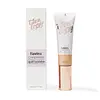Thin Lizzy Flawless Complexion Liquid Foundation Versus Andalou Naturals Age Defying Rejuvenating Eye Balm
What's inside
What's inside
 Key Ingredients
Key Ingredients

No key ingredients
 Benefits
Benefits

 Concerns
Concerns

 Ingredients Side-by-side
Ingredients Side-by-side

Water
Skin ConditioningCaprylyl Methicone
Skin ConditioningDimethicone
EmollientPolymethylsilsesquioxane
Isononyl Isononanoate
EmollientPEG/PPG-18/18 Dimethicone
EmulsifyingGlycerin
HumectantPropylene Glycol
HumectantC30-45 Alkyldimethylsilyl Polypropylsilsesquioxane
Caprylic/Capric Triglyceride
MaskingLauryl PEG-10 Tris(Trimethylsiloxy)Silylethyl Dimethicone
EmulsifyingZinc Stearate
Cosmetic ColorantSodium Chloride
MaskingStearalkonium Hectorite
Gel FormingSilica Silylate
EmollientPropylene Carbonate
SolventDisodium EDTA
Triethoxycaprylylsilane
Ethylhexylglycerin
Skin ConditioningPhenoxyethanol
PreservativeCI 77891
Cosmetic ColorantCI 77499
Cosmetic ColorantCI 77491
Cosmetic ColorantCI 77492
Cosmetic ColorantWater, Caprylyl Methicone, Dimethicone, Polymethylsilsesquioxane, Isononyl Isononanoate, PEG/PPG-18/18 Dimethicone, Glycerin, Propylene Glycol, C30-45 Alkyldimethylsilyl Polypropylsilsesquioxane, Caprylic/Capric Triglyceride, Lauryl PEG-10 Tris(Trimethylsiloxy)Silylethyl Dimethicone, Zinc Stearate, Sodium Chloride, Stearalkonium Hectorite, Silica Silylate, Propylene Carbonate, Disodium EDTA, Triethoxycaprylylsilane, Ethylhexylglycerin, Phenoxyethanol, CI 77891, CI 77499, CI 77491, CI 77492
Water
Skin ConditioningDicaprylyl Carbonate
EmollientCetyl Alcohol
EmollientGlyceryl Stearate
EmollientCaprylic/Capric Triglyceride
MaskingGlyceryl Stearate Citrate
EmollientStearyl Alcohol
EmollientMyristyl Myristate
EmollientGlycerin
HumectantSqualane
EmollientCetearyl Olivate
Sorbitan Olivate
EmulsifyingBakuchiol
Antimicrobial1,2-Hexanediol
Skin ConditioningCaprylyl Glycol
EmollientPolyglyceryl-6 Distearate
EmulsifyingMalus Domestica Fruit Cell Culture Extract
Skin ConditioningVitis Vinifera Fruit Cell Extract
Skin ConditioningAloe Barbadensis Leaf Juice
Skin ConditioningEuterpe Oleracea Fruit Extract
Aronia Melanocarpa Fruit Extract
Skin ConditioningLycium Barbarum Fruit Extract
AstringentTheobroma Grandiflorum Seed Butter
Skin ConditioningHelianthus Annuus Seed Oil
EmollientXanthan Gum
EmulsifyingIsomalt
HumectantLecithin
EmollientCamellia Sinensis Extract
AntioxidantPotassium Sorbate
PreservativeSodium Benzoate
MaskingSuperoxide Dismutase
AntioxidantAllantoin
Skin ConditioningTocopherol
AntioxidantWater, Dicaprylyl Carbonate, Cetyl Alcohol, Glyceryl Stearate, Caprylic/Capric Triglyceride, Glyceryl Stearate Citrate, Stearyl Alcohol, Myristyl Myristate, Glycerin, Squalane, Cetearyl Olivate, Sorbitan Olivate, Bakuchiol, 1,2-Hexanediol, Caprylyl Glycol, Polyglyceryl-6 Distearate, Malus Domestica Fruit Cell Culture Extract, Vitis Vinifera Fruit Cell Extract, Aloe Barbadensis Leaf Juice, Euterpe Oleracea Fruit Extract, Aronia Melanocarpa Fruit Extract, Lycium Barbarum Fruit Extract, Theobroma Grandiflorum Seed Butter, Helianthus Annuus Seed Oil, Xanthan Gum, Isomalt, Lecithin, Camellia Sinensis Extract, Potassium Sorbate, Sodium Benzoate, Superoxide Dismutase, Allantoin, Tocopherol
Ingredients Explained
These ingredients are found in both products.
Ingredients higher up in an ingredient list are typically present in a larger amount.
This ingredient is an emollient, solvent, and texture enhancer. It is considered a skin-softener by helping the skin prevent moisture loss.
It helps thicken a product's formula and makes it easier to spread by dissolving clumping compounds.
Caprylic Triglyceride is made by combining glycerin with coconut oil, forming a clear liquid.
While there is an assumption Caprylic Triglyceride can clog pores due to it being derived from coconut oil, there is no research supporting this.
Learn more about Caprylic/Capric TriglycerideGlycerin is already naturally found in your skin. It helps moisturize and protect your skin.
A study from 2016 found glycerin to be more effective as a humectant than AHAs and hyaluronic acid.
As a humectant, it helps the skin stay hydrated by pulling moisture to your skin. The low molecular weight of glycerin allows it to pull moisture into the deeper layers of your skin.
Hydrated skin improves your skin barrier; Your skin barrier helps protect against irritants and bacteria.
Glycerin has also been found to have antimicrobial and antiviral properties. Due to these properties, glycerin is often used in wound and burn treatments.
In cosmetics, glycerin is usually derived from plants such as soybean or palm. However, it can also be sourced from animals, such as tallow or animal fat.
This ingredient is organic, colorless, odorless, and non-toxic.
Glycerin is the name for this ingredient in American English. British English uses Glycerol/Glycerine.
Learn more about GlycerinWater. It's the most common cosmetic ingredient of all. You'll usually see it at the top of ingredient lists, meaning that it makes up the largest part of the product.
So why is it so popular? Water most often acts as a solvent - this means that it helps dissolve other ingredients into the formulation.
You'll also recognize water as that liquid we all need to stay alive. If you see this, drink a glass of water. Stay hydrated!
Learn more about Water